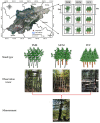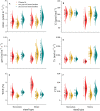Growing in Mixed Stands Increased Leaf Photosynthesis and Physiological Stress Resistance in Moso Bamboo and Mature Chinese Fir Plantations
- PMID: 34093612
- PMCID: PMC8173113
- DOI: 10.3389/fpls.2021.649204
Growing in Mixed Stands Increased Leaf Photosynthesis and Physiological Stress Resistance in Moso Bamboo and Mature Chinese Fir Plantations
Abstract
Mixed-stand plantations are not always as beneficial for timber production and carbon sequestration as monoculture plantations. Systematic analyses of mixed-stand forests as potential ideal plantations must consider the physiological-ecological performance of these plantations. This study aimed to determine whether mixed moso bamboo (Phyllostachys pubescens (Pradelle) Mazel ex J. Houz.) and Chinese fir (Cunninghamia lanceolata (Lamb.) Hook.) stands exhibited better physiological-ecological performance than monoculture plantations of these species. We analyzed leaf photosynthesis, chlorophyll fluorescence, antioxidant enzyme activities, chlorophyll content and leaf chemistry in a moso bamboo stand, a Chinese fir stand and a mixed stand with both species. The results showed that both species in the mixed stand exhibited significantly higher leaf net photosynthesis rate (Amax), instantaneous carboxylation efficiency (CUE), chlorophyll content, maximum quantum yield of photosynthesis (Fv/Fm), photochemical quenching coefficient (qP), PSII quantum yield [Y(II)], leaf nitrogen content, and antioxidant enzyme activities than those in the monoculture plantations. However, the non-photochemical quenching (NPQ) in Chinese fir and 2-year-old moso bamboo was significantly lower in the mixed stand than in the monocultures. In addition, the water use efficiency (WUE) of Chinese fir was significantly higher in the mixed stand. The results suggest that the increase in leaf net photosynthetic capacity and the improved growth in the mixed stand could be attributed primarily to the (i) more competitive strategies for soil water use, (ii) stronger antioxidant systems, and (iii) higher leaf total nitrogen and chlorophyll contents in the plants. These findings suggest that mixed growth has beneficial effects on the leaf photosynthesis capacity and physiological resistance of moso bamboo and Chinese fir.
Keywords: antioxidant enzyme; bamboo-fir mixture; chlorophyll fluorescence; leaf-level gas exchange; stand carbon sequestration; water use efficiency.
Copyright © 2021 Peng, Song, Li, Mei, Wu, Shi, Zhou and Zhou.
Conflict of interest statement
The authors declare that the research was conducted in the absence of any commercial or financial relationships that could be construed as a potential conflict of interest.
Figures





Similar articles
-
Effects of chlorophyll fluorescence on environment and gross primary productivity of moso bamboo during the leaf-expansion stage.J Environ Manage. 2024 Jun;360:121185. doi: 10.1016/j.jenvman.2024.121185. Epub 2024 May 23. J Environ Manage. 2024. PMID: 38788407
-
High nutrient utilization and resorption efficiency promote bamboo expansion and invasion.J Environ Manage. 2024 Jun;362:121370. doi: 10.1016/j.jenvman.2024.121370. Epub 2024 Jun 4. J Environ Manage. 2024. PMID: 38838536
-
Mixed plantations do not necessarily provide higher ecosystem multifunctionality than monoculture plantations.Sci Total Environ. 2024 Mar 1;914:170156. doi: 10.1016/j.scitotenv.2024.170156. Epub 2024 Jan 13. Sci Total Environ. 2024. PMID: 38219692
-
[Effects of intensive management on soil C and N pools and soil enzyme activities in Moso bamboo plantations.].Ying Yong Sheng Tai Xue Bao. 2016 Nov 18;27(11):3455-3462. doi: 10.13287/j.1001-9332.201611.029. Ying Yong Sheng Tai Xue Bao. 2016. PMID: 29696841 Chinese.
-
Alleviation of drought stress in Phyllostachys edulis by N and P application.Sci Rep. 2018 Jan 10;8(1):228. doi: 10.1038/s41598-017-18609-y. Sci Rep. 2018. PMID: 29321617 Free PMC article.
Cited by
-
Modeling of the Potential Geographical Distribution of Three Fritillaria Species Under Climate Change.Front Plant Sci. 2022 Jan 10;12:749838. doi: 10.3389/fpls.2021.749838. eCollection 2021. Front Plant Sci. 2022. PMID: 35082804 Free PMC article.
-
Age effects of Moso bamboo on leaf isoprene emission characteristics.Front Plant Sci. 2023 Mar 7;14:1132717. doi: 10.3389/fpls.2023.1132717. eCollection 2023. Front Plant Sci. 2023. PMID: 36959949 Free PMC article.
-
Comparative study of urea-15N fate in pure bamboo and bamboo-broadleaf mixed forests.Front Plant Sci. 2024 May 21;15:1382934. doi: 10.3389/fpls.2024.1382934. eCollection 2024. Front Plant Sci. 2024. PMID: 38835866 Free PMC article.
References
-
- Andrés E. G. D., Camarero J. J., Blanco J. A., Imbert J. B., Lo Y., Sangüesa-Barreda G., et al. (2017). Tree-to-tree competition in mixed European beech-Scots pine forests has different impacts on growth and water-use efficiency depending on site conditions. J. Ecol. 106 59–75. 10.1111/1365-2745.12813 - DOI
-
- Annicchiarico P., Barrett B., Brummer E. C., Julier B., Marshall A. H. (2015). Achievements and challenges in improving temperate perennial forage legumes. Crit. Rev. Plant Sci. 34 327–380. 10.1080/07352689.2014.898462 - DOI
-
- Ashraf M., Harris P. J. C. (2013). Photosynthesis under stressful environments: an over-view. Photosynthetica 51 163–190. 10.1007/s11099-013-0021-6 - DOI
Grants and funding
LinkOut - more resources
Full Text Sources

